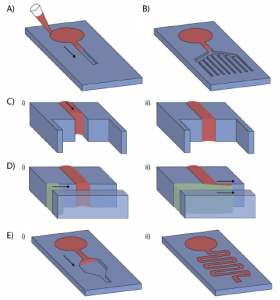 An interesting article from Ashleigh Théberge’s group at the University of Washington reviews the relatively recent introduction of open capillary microfluidic systems (as distinct from electrowetted digital microfluidics). The paper was recently pre-published in Analytical Chemistry as an ASAP article.
An interesting article from Ashleigh Théberge’s group at the University of Washington reviews the relatively recent introduction of open capillary microfluidic systems (as distinct from electrowetted digital microfluidics). The paper was recently pre-published in Analytical Chemistry as an ASAP article.
 The authors review a number of different channel geometries and fibre bundle configurations that can be used to promote open capillary flow. The helpfully provide the equations that use channel geometry and contact angle to determine whether capillary flow is energetically favourable. This is done for both conventional monolithic (single material) channels, as well as composite material channels.
The authors review a number of different channel geometries and fibre bundle configurations that can be used to promote open capillary flow. The helpfully provide the equations that use channel geometry and contact angle to determine whether capillary flow is energetically favourable. This is done for both conventional monolithic (single material) channels, as well as composite material channels.
Pros and cons of the open capillary approach are surveyed. The authors list several advantages:
- simplified fabrication by obviating the need for bonding and potential associated use of solvents on the substrate, process development/trade secrets, manufacturing cost, etc.;
- ease of performing surface modifications, such as for hydrophilicity/hydrophobicity, silanisation or other derivitisation, blanket or patterned exposure to UV, plasmas, chemical or physical vapour depositions (PVD & CVD), application of delicate bio-reagents that can’t withstand thermal bonding;
- accessibility of channels for adding or removing reagents or components with pipettes, tweezers (as for tissue scaffolds)
- elimination of air bubble issues, due to the open interface.
They also mention disadvantages primarily stemming from the open channel access such as higher evaporation, evolution and/or exchange of dissolved gases, liquid leaks to non-channel paths, and the inability to generate higher pressures in channels (beyond those of capillarity) and thus use valves, etc.
Lastly, a number of different applications are noted, though all appear to be academic in nature at this stage. While I see the advantages of flexibility and reduced manufacturing cost offered by the open channel concept, I wonder how a product would be able to mitigate against evaporation and contamination issues in viable approach suitable for a robust consumable suitable for untrained users. Perhaps the authors have the answers; they mention that they have financial interests in two companies, Salus Discovery and Stacks to the Future, involved in the commercialisation and IP related to some of the technologies presented.
